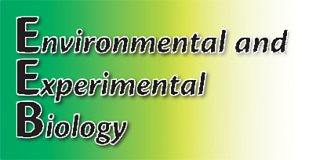
On-line: ISSN 2255–9582

| Faculty of Biology, University of Latvia | ||||||

|
Hard copy: ISSN 1691–8088
On-line: ISSN 2255–9582 Environ Exp Biol (2020) 18: 153–160
|
|||||

|
About the Journal | Retractions | Open Access | Author Guidlines | Current Issue | Archive |
|
Environmental and Experimental Biology |
Environ Exp Biol (2020) 18: 153–160 |
The increasing interest in a sustainable approach to biotechnological applications has tremendously invigorated the scope of natural pigments. In the present study, bacterial cultures were screened from environmental samples, and Serratia nematodiphila was identified as a potential prodigiosin producer. The pigment was characterized as prodigiosin on the basis of a presumptive acid test and observation of absorption maxima of acidified pigment at 535 nm. In order to increase prodigiosin production from the test isolate, various nutritional and physicochemical parameters were optimized. Experiments revealed that nutrient broth medium supplemented with 0.2% mannitol and 0.2% inorganic phosphate supported high pigment production. Optimum prodigiosin production was achieved when the nutrient broth media (with 1% NaCl) was adjusted to pH 8 and incubated at 25°C for 48 h. The optimized media showed over 64.78 and 73.23% increase in prodigiosin production as compared to the nutrient broth and Luria Bertani broth, respectively. The present study indicated a great potential of S. nematodiphila to produce prodigiosin by minimum optimization of culture medium.